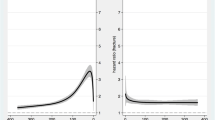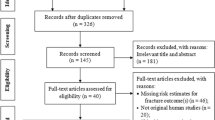Abstract
To study the risk of fractures associated with anxiolytics, sedatives, and hypnotics, we conducted a case-control study. Cases were all subjects with any fracture during the year 2000 (n = 124,655). For each case, three controls (n = 373,962) matched on age and gender were randomly drawn from the background population. The exposure was use of any anxiolytic, sedative, or hypnotics. Adjustments were made for a number of potential confounders. Most anxiolytics, sedatives, and hypnotics were associated with a limited increase in the risk of fractures. There was a dose-response relationship, and drugs with a half-life longer than 24 h were associated with a trend toward a higher relative risk of fractures than drugs with a shorter half-life. Both current use (last use <1 year ago) and past use (last use more than one year ago) were associated with an increased risk of fractures. We conclude that anxiolytics, sedatives, and hypnotics are associated with a limited increase in the risk of fractures. For most drugs a dose-response relationship was present, and drugs with a half-life >24 h tended to be associated with a higher risk of fractures than drugs with a shorter half-life. This points to a dose-dependent risk of, for example, falls leading to fractures. However, the increased risk of fractures with past use may suggest an effect of the condition for which the drug was prescribed rather than the drug per se (confounding by indication).

Similar content being viewed by others
References
Cummings SR, Nevitt MC, Browner WS et al. (1995) Risk factors for hip fracture in white women. Study of Osteoporotic Fractures Research Group. N Engl J Med 332:767–773
Ray WA, Griffin MR, Downey W (1989) Benzodiazepines of long and short elimination half-life and the risk of hip fracture. JAMA 262:3303–3307
Cumming RG, Klineberg RJ (1993) Psychotropics, thiazide diuretics and hip fractures in the elderly. Med J Aust 158:414–417
Tamblyn R, Abrahamowicz M, du BR et al. (2005) A 5-year prospective assessment of the risk associated with individual benzodiazepines and doses in new elderly users. J Am Geriatr Soc 53:233–241
Hoffmann F, Glaeske G (2006) [New use of benzodiazepines and the risk of hip fracture: a case-crossover study]. Z Gerontol Geriatr 39:143–148
Ensrud KE, Blackwell TL, Mangione CM, et al. (2002) Central nervous system-active medications and risk for falls in older women. J Am Geriatr Soc 50:1629–1637
Avidan AY, Fries BE, James ML, Szafara KL, Wright GT, Chervin RD (2005) Insomnia and hypnotic use, recorded in the minimum data set, as predictors of falls and hip fractures in Michigan nursing homes. J Am Geriatr Soc 53:955–962
Kinjo M, Setoguchi S, Schneeweiss S, et al. (2005) Bone mineral density in subjects using central nervous system-active medications. Am J Med 118:1414
Pierfitte C, Macouillard G, Thicoipe M, et al. (2001) Benzodiazepines and hip fractures in elderly people: case-control study. BMJ 322:704–708
Vestergaard P, Rejnmark L, Mosekilde L (2006) Anxiolytics, sedatives, antidepressants, neuroleptics and the risk of fracture. Osteoporosis Int 17:807–816
Frank L (2000) Epidemiology. When an entire country is a cohort. Science 287:2398–2399
Andersen TF, Madsen M, Jørgensen J, et al. (1999) The Danish National Hospital Register. Danish Med Bull 46:263–268
Vestergaard P, Mosekilde L (2002) Fracture risk in patients with celiac disease, Crohn’s disease, and ulcerative colitis: a nation-wide follow-up study in 16,416 patients in Denmark. Am J Epidemiol 156:1–10
Wacholder S, McLaughlin JK, Silverman DT, et al. (1992) Selection of controls in case-control studies. I. Principles. Am J Epidemiol 135:1019–1028
Capella D (1993) Descriptive tools and analysis. In: Dukes MNG (ed) Drug utilization studies: methods and uses. WHO Regional Publications, European Series No. 45. WHO, Copenhagen, pp 55–78
Nielsen GL, Sørensen HT, Zhou W et al. (1997) The pharmaco-epidemiologic prescription database of North Jutland. Int J Risk Saf Med 10:203–205
Rosenberg R, Sparle Christensen K, Jepsen PW (2007) Benzodiazepiner. In: Pedersen C, Bjerrum L, Dalhoff KP, Damkier P, Friis H, Hendel J (eds) Medicin.dk 2007. Infomatum A/S, Copenhagen, pp 368–371
Munk-Jørgensen P, Mortensen PB (1997) The Danish Psychiatric Central Register. Danish Med Bull 44:82–84
Miettinen OS (1985) Theoretical epidemiology: principles of occurrence research in medicine. Wiley & Sons, New York
Sidik K, Jonkman JN (2005) A note on variance estimation in random effects meta-regression. J Biopharm Stat 15:823–838
Knapp G, Hartung J (2003) Improved tests for a random effects meta-regression with a single covariate. Stat Med 22:2693–2710
Larsen ER, Mosekilde L, Foldspang A (2004) Correlates of falling during 24 h among elderly Danish community residents. Prev Med 39:389–398
O’Neill TW, Varlow J, Reeve J et al. (1995) Fall frequency and incidence of distal forearm fracture in the UK. J Epidemiol Commun Health 49:597–598
Herings RM, Stricker BH, de Boer A et al. (1995) Benzodiazepines and the risk of falling leading to femur fractures. Dosage more important than elimination half-life. Arch Intern Med 155:1801–1807
Vestergaard P (2005) Epilepsy, osteoporosis and fracture risk—a meta-analysis. Acta Neurol Scand 112:277–286
Acknowledgments
Danmarks Statistik (Statistics Denmark) is acknowledged for their help, without which this project would not have been possible. Research Librarian Ms. Edith Clausen is acknowledged for help with the references. The Danish Medical Research Council provided financial support (Grant 22-04-0495).
Author information
Authors and Affiliations
Corresponding author
Rights and permissions
About this article
Cite this article
Vestergaard, P., Rejnmark, L. & Mosekilde, L. Anxiolytics and Sedatives and Risk of Fractures: Effects of Half-life. Calcif Tissue Int 82, 34–43 (2008). https://doi.org/10.1007/s00223-007-9095-0
Received:
Accepted:
Published:
Issue Date:
DOI: https://doi.org/10.1007/s00223-007-9095-0




